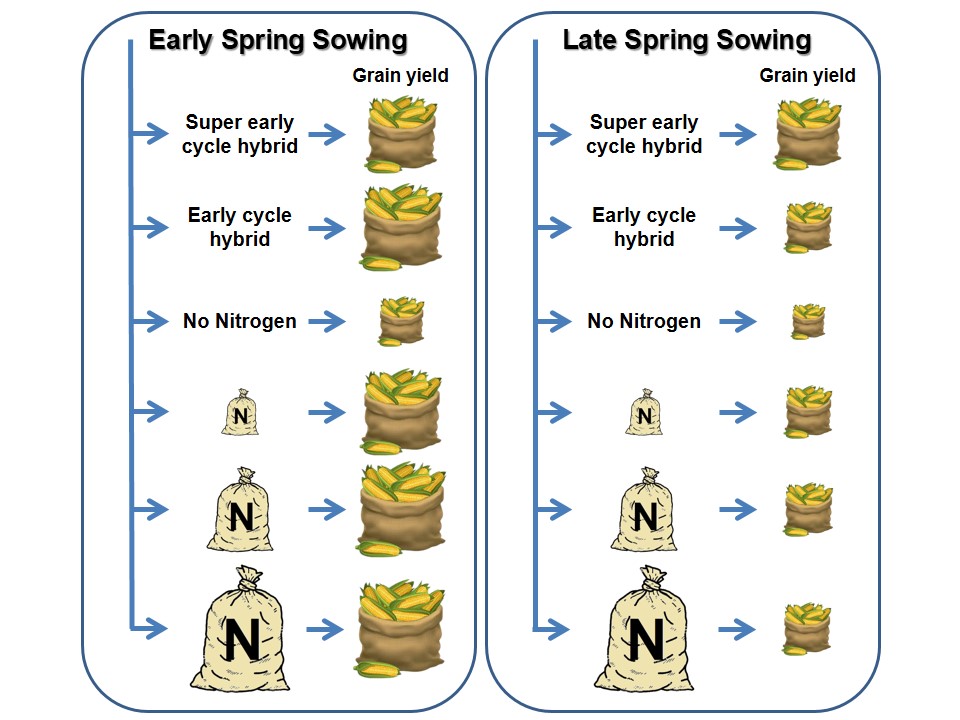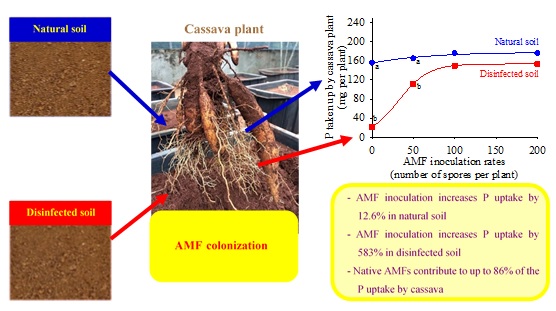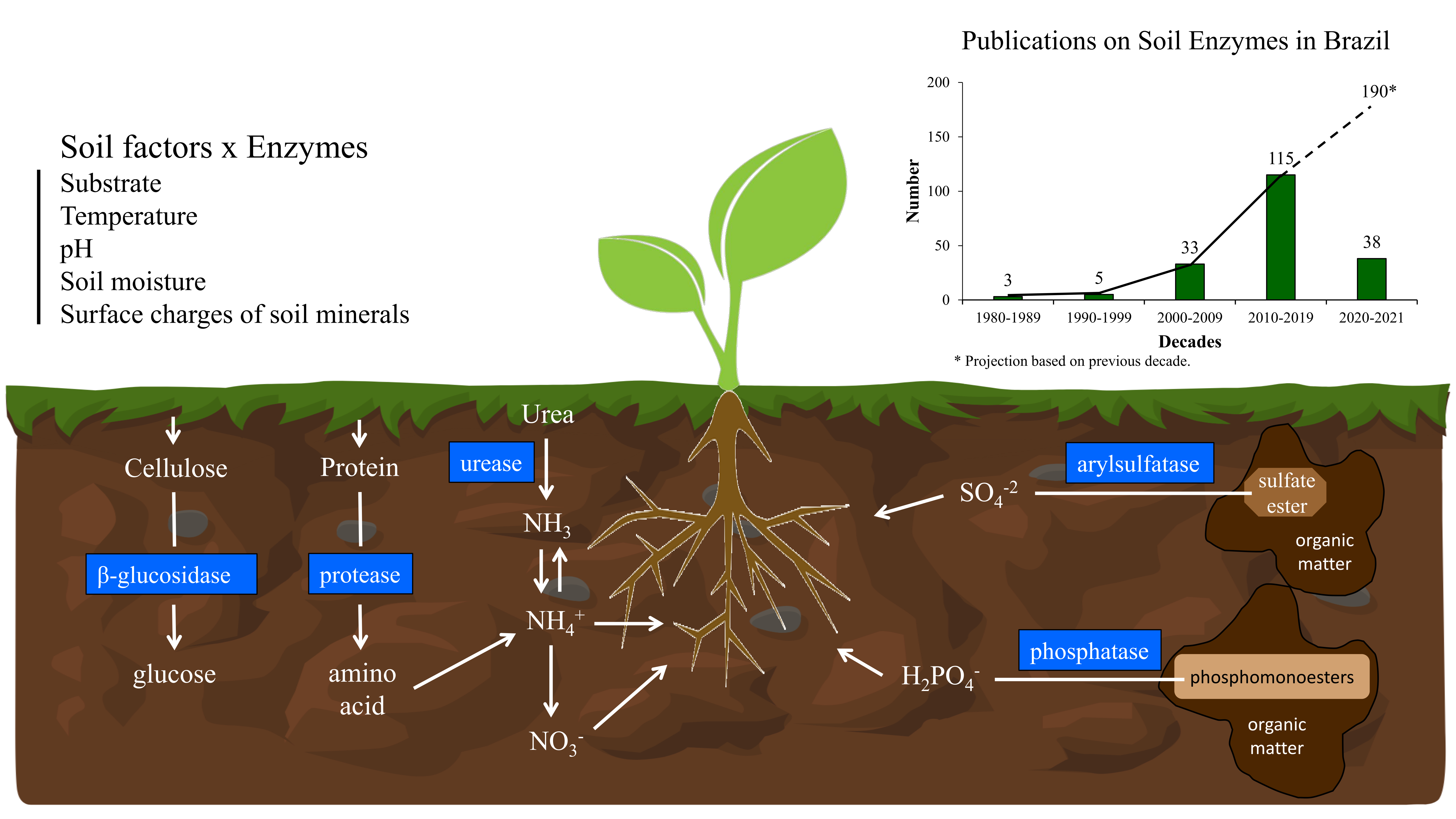Nitrogen use efficiency and grain yield of corn hybrids as affected by nitrogen rates and sowing dates in subtropical environment
13/Jan/2022
ABSTRACT Delay of sowing date in subtropical environments with long growing seasons can modify the yield response of corn hybrids to nitrogen (N) fertilization. This study evaluated the effects of the sowing time, and N top-dress rate on corn hybrids’ yield and N-use efficiency with different cycles. Two field experiments were carried out in subtropical environment of southern Brazil. The following factors were investigated: corn hybrids (AG9025, super early cycle and P30F53, early cycle), sowing times (early and late spring), […]
Growth and phosphorus uptake by cassava in P-deficient soil in response to mycorrhizal inoculation
30/Nov/2021
ABSTRACT Phosphorus (P) is one of the most difficult nutrients for plants to acquire because of its low content in the soil solution. Cassava (Manihot esculenta Crantz) has a thick and sparse absorbent root system; therefore, it is dependent on its association with arbuscular mycorrhizal fungi (AMF) for P acquisition from the soil. Thus, inoculation of cassava with AMF can improve the development of this root crop. This study evaluated the effects of soil disinfection (disinfected vs. natural) and the […]
Interplays between Atta ants (Formicidae: Attini), soils and environmental properties in the Brazilian Neotropics: a preliminary assessment
30/Nov/2021
ABSTRACT Leaf-cutting ants are the most important herbivore in the neotropics, represent active agents of pedobioturbation, and are regarded as ecosystem engineers. These ants have a wide variety of ecological functions, such as pollination, seed dispersal, and tree-growing control. Despite this importance, little is known on their distribution in relation to possible soil and environmental conditions that affect Atta ants occurrence. This study aimed to spatialize the main occurrences of Atta species in the Brazilian territory and evaluate the main […]
Contribution of enzymes to soil quality and the evolution of research in Brazil
30/Nov/2021
ABSTRACT Extracellular soil enzymes are fundamental for the functioning of ecosystems. Several processes in the soil depend on the activity of these enzymes, including plant decomposition, soil organic matter formation/mineralization, and nutrient cycling. Moreover, extracellular enzyme activity occurs in the soil and is therefore influenced by environmental factors. Due to the high sensitivity to these factors, extracellular enzymes are used for monitoring soil quality. This review aimed to present the main contributions of soil enzymes to agriculture, emphasizing the dynamics […]
Topsoil depth influences the recovery of rupestrian grasslands degraded by mining
24/Nov/2021
ABSTRACT Close association of iron mining and ferruginous rupestrian grassland places this ecosystem in a special condition of vulnerability, with a large number of degraded areas requiring restoration. Seedling transplantation and topsoil translocation can be used to recover native vegetation in degraded areas. This study aimed to experimentally test the application of two different topsoil depths (0.20 and 0.40 m) in a degraded area. We assessed the vegetation’s natural recovery and the survival of transplanted native species from rescue operations […]
Fine-scale soil mapping with Earth Observation data: a multiple geographic level comparison
24/Nov/2021
ABSTRACT Multitemporal collections of satellite images and their products have recently been explored in digital soil mapping. This study aimed to produce a bare soil image (BSI) for the São Paulo State (Brazil) to perform a pedometric analysis for different geographical levels. First, we assessed the potential of the BSI for predicting the surface (0.00-0.20 m) and subsurface (0.80-1.00 m) clay, iron oxides (Fe 2 O 3 ), aluminum (m%) and bases saturation (V%) contents at the state level, which […]
Optimized data-driven pipeline for digital mapping of quantitative and categorical properties of soils in Colombia
24/Nov/2021
ABSTRACT Soil maps provide a method for graphically communicating what is known about the spatial distribution of soil properties in nature. We proposed an optimized pipeline, named dino-soil toolbox, programmed in the R software for mapping quantitative and categorical properties of legacy soil data. The pipeline, composed of four main modules (data preprocessing, covariates selection, exploratory data analysis and modeling), was tested across a study area of 14,537 km 2 located between the departments of Cesar and Magdalena, Colombia. We […]
Use of nuclear techniques in soil science: A literature review of the Brazilian contribution
24/Nov/2021
ABSTRACT This review presents the basic research and some applications of the gamma-ray attenuation, neutron gauges, and 137Cs fallout techniques for studying soil physical processes and properties. The selected studies aimed to give the readers a general idea of the use of these nuclear techniques carried out by Brazilian researchers in the past decades. It is expected to assist future researchers by identifying knowledge gaps and opportunities for applying the methods presented here. Around 100 studies were selected for this […]
Teaching soil science: The impact of laboratory and field components on the knowledge and attitude toward soil
24/Nov/2021
ABSTRACT The concept of attitude toward soil is emerging, with a slim choice of scales available to collect hard data. There is also a dearth of standard scales to acquire precise data on students’ knowledge of soil. Therefore, the objectives of the present study were: (1) to devise appropriate scales to quantify theoretical soil knowledge and attitude toward soil, and (2) to quantify the effect of laboratory studies and fieldwork on students’ theoretical soil knowledge and attitude toward soil. The […]
Soil loss estimated by means of the RUSLE model in a subtropical climate watershed
24/Nov/2021
ABSTRACT Erosion process occurs naturally, shaping the Earth’s surface. Soil loss can cause harmful effects to the environment when intensive anthropic activities occur. Mathematical models have been used as effective and less costly alternatives for identifying sites highly prone to soil loss, especially at the watershed scale. In Brazil, the Revised Universal Soil Loss Equation (RUSLE) is one of the most commonly used soil loss prediction models. The RUSLE requires information on soil erodibility, rainfall erosivity, topography, land use and […]









